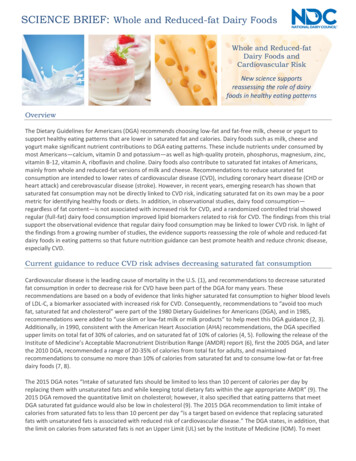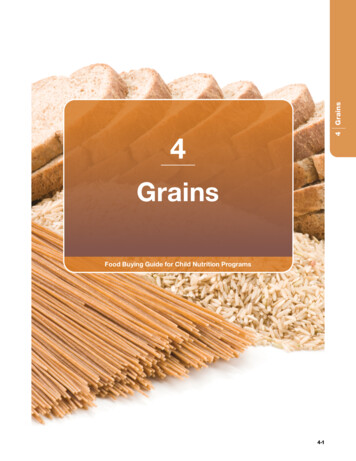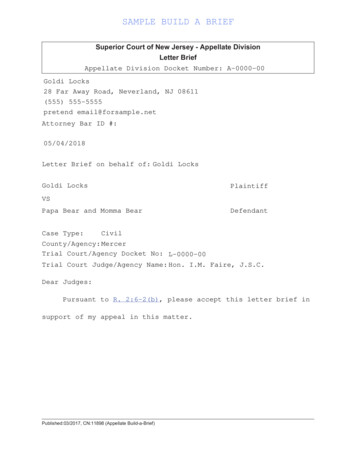
Transcription
SCIENCE BRIEF: Whole and Reduced-fat Dairy FoodsWhole and Reduced-fatDairy Foods andCardiovascular RiskNew science supportsreassessing the role of dairyfoods in healthy eating patternsOverviewThe Dietary Guidelines for Americans (DGA) recommends choosing low-fat and fat-free milk, cheese or yogurt tosupport healthy eating patterns that are lower in saturated fat and calories. Dairy foods such as milk, cheese andyogurt make significant nutrient contributions to DGA eating patterns. These include nutrients under consumed bymost Americans—calcium, vitamin D and potassium—as well as high-quality protein, phosphorus, magnesium, zinc,vitamin B-12, vitamin A, riboflavin and choline. Dairy foods also contribute to saturated fat intakes of Americans,mainly from whole and reduced-fat versions of milk and cheese. Recommendations to reduce saturated fatconsumption are intended to lower rates of cardiovascular disease (CVD), including coronary heart disease (CHD orheart attack) and cerebrovascular disease (stroke). However, in recent years, emerging research has shown thatsaturated fat consumption may not be directly linked to CVD risk, indicating saturated fat on its own may be a poormetric for identifying healthy foods or diets. In addition, in observational studies, dairy food consumption—regardless of fat content—is not associated with increased risk for CVD, and a randomized controlled trial showedregular (full-fat) dairy food consumption improved lipid biomarkers related to risk for CVD. The findings from this trialsupport the observational evidence that regular dairy food consumption may be linked to lower CVD risk. In light ofthe findings from a growing number of studies, the evidence supports reassessing the role of whole and reduced-fatdairy foods in eating patterns so that future nutrition guidance can best promote health and reduce chronic disease,especially CVD.Current guidance to reduce CVD risk advises decreasing saturated fat consumptionCardiovascular disease is the leading cause of mortality in the U.S. (1), and recommendations to decrease saturatedfat consumption in order to decrease risk for CVD have been part of the DGA for many years. Theserecommendations are based on a body of evidence that links higher saturated fat consumption to higher blood levelsof LDL-C, a biomarker associated with increased risk for CVD. Consequently, recommendations to “avoid too muchfat, saturated fat and cholesterol” were part of the 1980 Dietary Guidelines for Americans (DGA), and in 1985,recommendations were added to “use skim or low-fat milk or milk products” to help meet this DGA guidance (2, 3).Additionally, in 1990, consistent with the American Heart Association (AHA) recommendations, the DGA specifiedupper limits on total fat of 30% of calories, and on saturated fat of 10% of calories (4, 5). Following the release of theInstitute of Medicine’s Acceptable Macronutrient Distribution Range (AMDR) report (6), first the 2005 DGA, and laterthe 2010 DGA, recommended a range of 20-35% of calories from total fat for adults, and maintainedrecommendations to consume no more than 10% of calories from saturated fat and to consume low-fat or fat-freedairy foods (7, 8).The 2015 DGA notes “Intake of saturated fats should be limited to less than 10 percent of calories per day byreplacing them with unsaturated fats and while keeping total dietary fats within the age appropriate AMDR” (9). The2015 DGA removed the quantitative limit on cholesterol; however, it also specified that eating patterns that meetDGA saturated fat guidance would also be low in cholesterol (9). The 2015 DGA recommendation to limit intake ofcalories from saturated fats to less than 10 percent per day “is a target based on evidence that replacing saturatedfats with unsaturated fats is associated with reduced risk of cardiovascular disease.” The DGA states, in addition, thatthe limit on calories from saturated fats is not an Upper Limit (UL) set by the Institute of Medicine (IOM). To meet
SCIENCE BRIEF: Whole and Reduced-fat Dairy Foods and CVD Risksaturated fat guidelines in the context of dairy consumption, the DGA recommends choosing low-fat or fat-free dairyfoods, more milk and yogurt in place of cheese, and choosing lower fat cheese in place of regular cheese.On the other hand, the American Heart Association (AHA), in their dietary recommendations for CVD, have beenmore aggressive regarding saturated fat recommendations than the DGA. In 2006 the American Heart Associationrecommended limiting intake of saturated fat to 7% of energy and choosing low-fat or fat-free dairy products to helpmeet these recommendations (10). The 2013 AHA/ American College of Cardiology (ACC) Guideline on LifestyleManagement to Reduce Cardiovascular Risk recommends, for adults who would benefit from lower LDL-cholesterol(LDL-C or “bad” cholesterol), “Aim for a dietary pattern that achieves 5-6% of calories from saturated fat” as part of ahealthy dietary pattern (11). Like the DGA, they did not include a quantitative cholesterol guideline, noting “there isinsufficient evidence to determine whether lowering dietary cholesterol reduces LDL–C” (11). To provide guidanceabout how to meet saturated fat recommendations, AHA and others have developed communications aimed atconsumers that identified saturated fat, in addition to trans fat, as “bad fat,” to be reduced or avoided (12, 13).Healthy eating patterns are also linked to reduced chronic disease riskThe 2015 DGA states that “Previous editions of the Dietary Guidelines relied on the evidence on relationshipsbetween individual nutrients, foods, and food groups and health outcomes”; however, they also note that “dietarycomponents of an eating pattern can have interactive, synergistic, and potentially cumulative relationships, such thatthe eating pattern may be more predictive of overall health status and disease risk than individual foods or nutrients”(9). Overall, the 2015 DGA recommendations “are ultimately intended to help individuals improve and maintainoverall health and reduce the risk of chronic disease. Its focus is disease prevention, not treatment.”The 2015 DGA found that “Strong evidence shows that healthy eating patterns are associated with a reduced risk ofcardiovascular disease (CVD),” which was the strongest grade for any chronic disease or health condition theyreviewed (9). Healthy eating patterns were defined, in general, as including low-fat or fat-free dairy foods, vegetablesfrom all subgroups, fruits (mostly whole), grains (half of them whole), a variety of protein foods, and oils. They alsorecommended specific eating patterns to exemplify the general recommendations, including the Healthy U.S.-StylePattern, which is unchanged from 2010, and two variations, the Healthy Vegetarian and Healthy Mediterranean-StylePatterns.Characteristics of these eating patterns are similar to recommendations in the 2013 AHA/ACC lifestyle guidelines foradults who would benefit from blood pressure lowering or LDL-C lowering (11). The AHA/ACC recommend a dietarypattern that emphasizes consumption of vegetables, fruits, and whole grains; includes low-fat dairy products,poultry, fish, legumes, nontropical vegetable oils, and nuts; and limits intake of sweets, sugar-sweetened beverages,and red meats (11).In the U.S., current guidance from the DGA and AHA/ACC have recommendations in common for food-based eatingpatterns, as well as nutrient-based guidance to reduce saturated fat. Ultimately, dietary guidance may benefit frombetter integrating food-based guidance by acknowledging that individual foods may have unique effects beyond theirnutrient composition, and that guidance regarding individual nutrients may be more meaningful if presented in thecontext of the foods that contain them.Emerging evidence indicates saturated fat consumption may not be linked to CVD riskWhile authoritative guidance continues to recommend reducing saturated fat consumption to reduce risk for CVD,over the past ten years, emerging research examining saturated fat consumption and cardiovascular diseaseendpoints indicates that saturated fat per se may not be directly associated with CVD risk. Several publications havefound that populations consuming higher amounts of saturated fat do not have higher risk for CVD than those who2
SCIENCE BRIEF: Whole and Reduced-fat Dairy Foods and CVD Riskconsume lower amounts (14-16). One of these, for example, conducted for the World Health Organization andpublished in 2015, found “no clear association between higher intake of saturated fats and all-cause mortality, CHD,CHD mortality, ischemic stroke, or type 2 diabetes among apparently healthy adults” (16). On the other hand,consumption of industrially-produced trans fats was associated with all-cause mortality, CHD and CHD mortality (16).In summary, this emerging scientific evidence examining disease endpoints, rather than LDL-C, indicates that thebiomarker broadly used as a primary parameter to predict risk for CVD risk might not be the most appropriate in allcases.Emerging evidence indicates dairy food consumption is linked to lower risk for CVDDuring the same timeframe that the new evidence on saturated fat and CVD was emerging, another growing body ofevidence has shown that consumption of dairy foods, including whole, reduced-fat, low-fat and fat-free, has eitherneutral or inverse associations with risk for CVD. The 2010 Dietary Guidelines Advisory Committee (DGAC) reviewedevidence about the health effects of foods and food groups to inform recommendations to build healthy eatingpatterns (17). For dairy foods, the 2010 DGAC reviewed evidence published through mid-2009 about the relationshipbetween milk and milk product consumption and selected health outcomes. Based on that review, the 2010 DGAstated: “Moderate evidence indicates that intake of milk and milk products is associated with a reduced risk ofcardiovascular disease and type 2 diabetes and with lower blood pressure in adults” (8).Since 2009, the evidence about dairy food consumption and beneficial or neutral outcomes for CVD continues togrow. Between 2009 and 2015, three meta-analyses and 15 cohort studies have been published (18-35). Overall, thisbody of evidence indicates that higher consumption of milk, cheese and yogurt is not linked to higher risk for CVD,CHD or stroke, and in some cases, consumption is linked to lower risk. Neutral or inverse associations with risk forCVD have been observed with consumption of all fat levels of dairy foods, not only with low-fat or fat-free. Thesestudies, therefore, have found that dairy food consumption, regardless of fat content, has neutral or beneficialassociations with risk for CVD. The selected studies below have contributed to a better understanding of dairy foodconsumption and risk for CVD. Dairy food consumption and risk for stroke, CVD and CHD has been investigated in four large adult Europeancohorts followed for at least 10 years. Findings include: low-fat dairy food consumption was associated withreduced risk for stroke, while other dairy foods did not change stroke risk (18); total dairy foods and totalcheese were associated with reduced risk for heart attack (19); fermented milk was associated withdecreased risk for incident CVD, and cheese intake was associated with decreased risk for CVD risk in womenbut not in men (20); and dairy food intake was not associated with risk for CHD or stroke (21). A dose-response meta-analysis of 17 prospective cohort studies on milk and dairy products including morethan 600,000 adults found a moderate benefit of total milk consumption on CVD risk based on four of thesestudies (22). The relative risk was reduced by 6% with each 200 ml per day increase in milk consumption (one8 ounce cup 240 ml). There was no association between milk consumption and total mortality, stroke orCHD. A meta-analysis of 15 prospective cohort studies in adults found total dairy products, low-fat dairy products,milk and cheese were associated with a lower risk for stroke (23). A meta-analysis of 22 prospective cohort studies in adults found total dairy food consumption was associatedwith lower risk for CVD and lower risk for stroke but not CHD (24). Consumption of low-fat dairy productswas associated with a lower risk for stroke, while cheese was associated with a lower risk for stroke and CHD.Because the majority of evidence on these dairy health outcomes is observational, and the heterogeneity of dairyfoods in observational studies can make it difficult to tease out the effects of specific high-fat or low-fat dairy foods,randomized controlled trials are needed to better understand the dairy components and potential mechanismsunderlying these observations.3
SCIENCE BRIEF: Whole and Reduced-fat Dairy Foods and CVD RiskIn the context of the emerging evidence indicating that saturated fat per se may not be associated with higher riskfor CVD, and that dairy food consumption—including whole, reduced-fat, low-fat and fat-free versions—is neutral orlinked to lower risk for CVD, what evidence can help explain these findings? Three areas of investigation may helpaddress this question, including dairy fat composition, the effect of replacement nutrients when reducing saturatedfat, and the food matrix of dairy foods.Dairy fat is unique and complexThe phrase “saturated fat” is a useful description of the chemical structure of a fatty acid, but it does not helpillustrate the variety of fatty acids found in dairy fat. Whole milk contains about 3-4% dairy fat by weight, and dairyfat is made up of more than 400 different types of fatty acids, making it the most complex fat naturally occurring in afood (36). In the U.S., about two-thirds of the fatty acids in milk are saturated, and one third are unsaturated(including monounsaturated and polyunsaturated fatty acids) (37), though the types and proportions of fatty acids inmilk can vary (36, 38).Differential biological effects of saturated fatty acids in dairy foods may also contribute to the complexity of dairy fat.Among the saturated fatty acids, dairy fat contains short-, medium- and long-chain fatty acids from four to 18carbons in length. The four most common saturated fatty acids in dairy fat, containing 12, 14, 16 or 18 carbons, havedifferent effects on blood levels of LDL-C, HDL-cholesterol (HDL-C) or “good” cholesterol, and triglycerides (39).Stearic acid, containing 18 carbons, has no effect on LDL-C, while the other three raise blood levels of LDL-C, but alsoraise blood levels of HDL-C and lower triglycerides, a pattern associated with reduced risk for CVD (39, 40). Dairy fatalso contains small amounts of saturated fatty acids produced by rumen bacteria that contain 15 and 17 carbons.These fatty acids have been studied as a way to accurately measure dairy fat intake. One study found a saturated fatmarker of dairy food intake was associated with lower risk for CVD and CHD (41), and another found intake ofcheese, and 15 and 17 carbon fatty acids, were associated with lower risk for first heart attack in women (42).Though scientists have more to learn about the health implications of dairy fat, the fatty acid profile of this unique fatmay contribute to the observed associations between dairy foods and reduced chronic disease risk, and it may helpexplain why the link between consuming dairy foods on CVD risk is not easily predicted by saturated fat content.Replacing saturated fat with other macronutrients may modulate CVD riskAs a way to understand the findings of no association between saturated fat and CVD outcomes, another emergingarea of research has examined changes in risk associated with different replacement nutrients. Both observationalstudies and trials have evaluated how replacing dietary saturated fat with macronutrients such as unsaturated fat orcarbohydrates influences risk for CVD. In general, in large prospective studies and a meta-analysis, replacingsaturated fat with polyunsaturated fat has been linked to reduced risk for CVD, while replacing saturated fat withcarbohydrates has little or no benefit (14-16, 43-46). A Cochrane review of intervention trials assessed the effect ofreducing saturated fat consumption and replacing it with carbohydrate, polyunsaturated fat or monounsaturated faton mortality and cardiovascular morbidity (47). The review found no effect of reducing saturated fat, compared tousual diet, on risk for all-cause mortality or cardiovascular mortality (47). Compared to usual diet, however, loweringsaturated fat consumption reduced the risk for cardiovascular events (heart attacks and stroke, combined). Insubgroup analyses, the reduction in cardiovascular events was seen in studies that replaced saturated fat withpolyunsaturated fat, but not with monounsaturated fat, carbohydrates, or protein (47).This research acknowledges the nutrient trade-offs that inevitably occur with recommendations to reduce individualdietary components. In general, replacement of saturated fat with polyunsaturated fat appears to reduce risk, but4
SCIENCE BRIEF: Whole and Reduced-fat Dairy Foods and CVD Riskreplacement with simple or refined carbohydrates does not, in both observational and trial data (16, 47). Oneinterpretation of these results is that saturated fat may be more of a neutral participant, with the effects of reductiondue to the effects of the replacement nutrients. In the context of overall eating patterns, however, this approachmay overstate the importance of macronutrient replacements. That’s because people eat foods that contain thesetypes of fat, not only the fat itself. Different food sources of fat contribute additional nutrients and bioactivecompounds to the diet that may impact disease risk, and studying individual nutrients may not account for the totalfood effects (48).Food source matters when it comes to the link between fat consumption and CVD riskThe food matrix has been defined as “The nutrient and non-nutrient components of foods and their molecularrelationships, i.e. chemical bonds, to each other” (49). It refers to the physical form of a food, and how itscomponents, including nutrients, interact with each other. It is a helpful concept when examining the differenteffects of food sources of saturated fat on biological or health outcomes. Research indicates that the food matrix ofdairy foods may modulate the effects of dairy fat on CVD biomarkers and associated risk.Cheese consumption has effects that differ from what would be expected based only on saturated fat content. Ameta-analysis of five clinical trials on cheese consumption and blood lipids found that hard cheese lowers bloodlevels of total cholesterol, LDL-C and HDL-C in trials that compare cheese consumption to the equivalent amount ofdairy fat (as butter) (50). The authors noted that “the results consistently showed that the effects of cheese on lipidsand lipoproteins were different than expected from the fat content.” They also concluded that more research isneeded to help determine the characteristics of cheese that may contribute to these findings, indicating the calciumcontent, specific types of fatty acids, and effects of the food matrix in cheese warrant further study (50).Beef, cheese and milk are among the top food sources of dietary saturated fat in the U.S. (51), and most studiescombine food sources of saturated fat when evaluating links to CVD risk. In the Multi Ethnic Study of Atherosclerosis(MESA) adult cohort, researchers compared risk for CVD associated with consumption of saturated fat from meat ordairy (33). Consumption of saturated fat from meat was associated with a higher risk for CVD, while consumption ofsaturated fat from dairy foods was associated with lower risk for CVD. Each 5 gram increase in dairy saturated fat perday was associated with 21% lower risk for CVD, and each 5% increase in energy from dairy saturated fat wasassociated with 38% lower risk (33). Though more research is needed to determine what is driving this difference, theauthors point out that “health effects of the entire food rather than the content of any single nutrient might be mostrelevant to understanding associations between dietary consumption and health outcomes.” The authors also notethat the observed differences between food-specific saturated fat and CVD may explain why “overall saturated fatconsumption, summed from all sources, has not been significantly associated with incident CVD ” (33). Thus,specifying the food source of saturated fat may be helpful information in nutrition guidance.A prospective study conducted in a large Dutch adult population found that higher saturated fat consumption wasassociated with lower risk for ischemic heart disease (IHD) (52). Researchers modeled replacing saturated fat withother macronutrients, and they also separated out dairy fatty acids from other sources of saturated fat. Theyconcluded that lower IHD risk “did not depend on the substituting macronutrient” but rather depended on the fattyacids found in dairy foods, specifying “the chain length and food source of saturated fatty acids” that were associatedwith lower risk. These included a slightly lower risk of IHD associated with the sum of short chain fatty acids (four to10 carbons) and odd-chain fatty acids (15 and 17 carbons) commonly found in dairy fat, as well as the saturated fattyacids from specific dairy foods, including butter, cheese, and milk and milk products. They found no associationsbetween intakes of saturated fat from other food sources and IHD risk. Unlike previous studies, they found replacingsaturated fat with carbohydrates, polyunsaturated fat or animal protein was associated with a higher risk for IHDcompared to saturated fatty acids. These results are of special interest because this Dutch population had a fairly5
SCIENCE BRIEF: Whole and Reduced-fat Dairy Foods and CVD Riskhigh intake of saturated fat from dairy, with cheese, milk and milk products, and butter contributing 41% of saturatedfat intake.The Dutch study and the MESA study, above, are the only two observational studies to date that have examinedcontributions of dairy saturated fat separately from other contributors. Both found a lower risk associated withconsumption of saturated fat from dairy foods; however, neither was able to determine whether the result was dueto the dairy fat alone or the characteristics of the dairy food with which the fat was consumed, or both.A modified DASH diet containing whole milk dairy foods maintains DASH benefitsWhile the majority of the studies described in this brief are observational, a controlled trial published in 2015contributed valuable information about the health effects of including higher fat dairy foods in a modified DASH diet.The standard DASH eating pattern is a reduced-fat plan containing, daily, eight-10 servings of fruits and vegetables,two-three servings of dairy, whole grains, poultry, fish and nuts (53). Characteristics of the DASH eating plan areconsistent with the DGA (8, 9). Study participants consumed each of three diets for three weeks, separated by twoweek washout periods: a control diet, the standard DASH diet, and a modified high-fat DASH diet in which low-fat orfat-free dairy foods were replaced with regular (full-fat) versions and carbohydrates were reduced to maintaincalories (54). Compared to the standard DASH diet, the modified DASH diet increased saturated fat from 8% to 14%of calories, increased total fat from 27% to 40% of calories, and reduced carbohydrates from 55% to 43% of calories.Researchers measured the effects on blood pressure and blood lipid markers. Compared to the standard DASH diet,the modified DASH diet had the same effect on blood pressure lowering, reduced blood levels of triglycerides, anddid not increase total or LDL-C or HDL-C (54). This study demonstrates that whole milk dairy foods can beincorporated into a healthy dietary pattern that is calorie-balanced and improves standard biomarkers related toheart disease. More randomized controlled trials that incorporate whole and reduced-fat dairy foods into balancedeating patterns are needed to help understand the mechanisms underlying these effects, as well as the impact ofsuch diets longer term.What is the role of whole and reduced-fat dairy foods in dietary guidance?Because the link between saturated fat consumption and LDL-C has been a main rationale for recommending low-fator fat-free dairy foods in nutrition guidance, research summarized in this brief that finds dairy food consumption isnot linked to increased risk for CVD, and is in some cases beneficial, plus the trial that found a modified DASH dietcontaining whole milk dairy foods resulted in beneficial changes to CVD risk factors, together point to the need for aholistic perspective on dairy foods in healthy eating patterns.The evolution of the science on saturated fat and CVD outcomes has been accompanied by calls to reassess dietaryrecommendations for saturated fat, including dairy foods, by various researchers in the field during the last five years(45, 55-57). For example, Lamarche proposed a re-evaluation in a paper published in 2014:“Dietary recommendations have changed little over the years and the early focus on SFA [saturated fattyacids] remains omnipresent in most guidelines. Based on recent controversial and inconsistent evidencefrom epidemiological and intervention studies, it seems reasonable to revisit this SFA–CVD scheme. Webelieve that evidence regarding the impact of dietary SFA on CVD risk factors other than LDL-cholesteroland evidence regarding whole foods rather than just SFA, both from clinical as well as epidemiologicalperspectives, need to be considered in the future (55).”6
SCIENCE BRIEF: Whole and Reduced-fat Dairy Foods and CVD RiskIn a comprehensive authoritative review, published in 2016, entitled Dietary and Policy Priorities for CardiovascularDisease, Diabetes, and Obesity: A Comprehensive Review, Mozzafarian summarized current research on dairy foodsthis way, calling for “substantial further investment in research on cardiometabolic effects of dairy foods”:“No long-term studies support harms, and emerging evidence suggests some potential benefits, of dairyfat or high-fat dairy foods such as cheese. Together these findings provide little support for the prevailingrecommendations for dairy intake that are based largely on calcium and vitamin D contents, rather thancomplete cardiometabolic effects; that emphasize low-fat dairy based on theorized influences on obesityand CHD, rather than empirical evidence; or that consider dairy as a single category, rather than separatelyevaluating different dairy foods (56).”The 2015 DGA embodies the idea that “a healthy eating pattern is not a rigid prescription, but rather, an adaptableframework in which individuals can enjoy foods that meet their personal, cultural, and traditional preferences and fitwithin their budget” (58). To develop the 2015 DGA eating pattern recommendations, studies linking healthoutcomes with eating patterns such as DASH, Mediterranean and vegetarian diets were evaluated, and the 2015 DGAstated that the evidence on food groups and various health outcomes reflected in the 2015 DGA “complements andbuilds on the evidence of the previous 2010 edition.” The 2015 DGAC did not review evidence about the healtheffects associated with any individual foods or food groups, including dairy foods (58), so research studies about theassociations between dairy foods and risk for CVD published after 2009 were not included in the 2015 DGACevidence review.The DGA recommends increasing daily consumption of dairy foods, vegetables, fruits, and whole grains to increaseintakes of calcium, vitamin D potassium, and dietary fiber (9); to meet saturated fat recommendations, the DGArecommends shifting away from choosing whole and reduced-fat milk, cheese and yogurt, in favor of low-fat or fatfree versions, among other strategies. Most Americans 9 years and older do not meet dairy recommendations forthree daily servings of low-fat or fat-free dairy foods as outlined in the Healthy U.S-Style Eating Pattern of the DGA(9). Average intakes are about two servings per day for Americans 2 years and older (59), and despite the wideavailability of low-fat and fat-free milk and authoritative recommendations to choose it, the majority of milkconsumed in the U.S. is whole or reduced-fat (60). To help meet dairy recommendations and help reduce risks forchronic disease, it may be that nutrient-rich whole and reduced-fat milk, cheese and yogurt are not the foods thatconsumers should focus on when attempting to decrease dietary saturated fat levels.While whole and reduced-fat dairy foods contain more calories than low-fat and fat-free versions, a systematicreview concluded that the observational evidence does not support an association between dairy fat or high-fat dairyfoods and obesity or cardiometabolic risk (61), and a study of three prospective cohorts found no link between theconsumption of most dairy foods and long-term weight gain (62). In a Women’s Health Study cohort of more than18,000 women followed for 17 years, among women who were normal weight at baseline, higher intake of high-fatdairy products, but not of low-fat dairy products, was associated with less weight gain (63). Consumption of high-fatdairy was also associated with lower risk for overweight and obesity, but total dairy, low-fat dairy, specific dairyproducts except yogurt, and calcium or vitamin D were not (63). The trial that compared a modified DASH dietcontaining whole milk dairy foods to the standard DASH diet provides an example of a calorie-balanced, healthyeating pattern that accommodated the additional calories from dairy foods by reducing carbohydrate content, mainlysugars (54). Standard advice to manage calories and saturated fat intakes by choosing only low-fat or fat-free dairyfoods may not be the only
fat, saturated fat and cholesterol" were part of the 1980 Dietary Guidelines for Americans (DGA), and in 1985, recommendations were added to "use skim or low-fat milk or milk products" to help meet this DGA guidance (2, 3). . more aggressive regarding saturated fat recommendations than the DGA. In 2006 the American Heart Association











